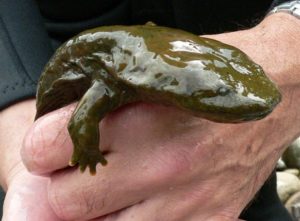
The Eastern Hellbender salamander became the official state amphibian in April, in an effort spearheaded by Sen. Gene Yaw. The presence of the salamanders indicates clean, healthy water. PHOTO FROM LYCOMING COLLEGE WEBSITE
Loud applause from environmentalists, ecologists and clean water advocates greeted the selection of the Eastern Hellbender salamander as Pennsylvania’s official amphibian last month.
Officially recognized with Gov. Tom Wolf’s signature April 16, the nocturnal water dweller, kind of a cross between a lizard and a frog, stole into prominence joining other official state symbols recognized throughout the years by the Pennsylvania General Assembly: the state insect, the firefly (1974), the state beverage, milk (1982), and the state flower, the mountain laurel (1933).
Lycoming College’s Clean Water Institute chalks up the river dweller’s elevation to state symbol status as a victory. The Hellbender is the school’s unofficial mascot and Sen. Gene Yaw (R-23), a 1970 Lycoming business administration graduate who represents part of Susquehanna County, sponsored the move in the Senate.
“Because the Eastern Hellbender exemplifies what is good about Pennsylvania’s waterways, it is the perfect selection to become the official State Amphibian,” Yaw said in a statement circulated by the college.
“It is an excellent natural indicator of water quality, so, in effect, if you have hellbenders in your water the water quality most likely is very good. The hellbender will be a visible symbol of Pennsylvania’s commitment to clean water,” Yaw said.
The Smithsonian National Zoo and Conservation Biology Institute describes the Hellbender salamander as having a “flattened head and body, four short, stout legs, long rudder-like tail and very small beady eyes.” Hellbender sleep all day, hiding under large rocks, eating crawfish, toads, snakes and fish. They have no eyelids, the Smithsonian notes.
Clean Water Institute student interns have caught over 3,000 hellbenders for study since 2006. The Hellbender is the largest salamander in North America. Clean Water Institute interns have also collected Hellbender eggs to hatch and release Hellbenders into the wild.
Melvin Zimmerman, professor emeritus of biology and director of the Clean Water Institute, emphasized that the presence of healthy Hellbenders indicate clean, healthy water.
“It is an indicator of clean water and like ‘the canary in a coal mine’ can be used to indicate watershed stress,” Zimmerman said in a statement distributed by the college.
“The Hellbender is the largest salamander in all of North America and third largest in the world! It is a unique ancient animal that can live for 40 years and obtain a length of 29 inches. These and other traits in the life cycle of the Hellbender make it a deserving symbol for Pennsylvania,” Zimmerman said.
Clean Water Institute research associate, Dr. Peter Petokas, and interns have been monitoring the health of Hellbender populations in Pennsylvania and southern New York for more than 12 years.
What Wolf signed into law last month started when high schoolers with the Chesapeake Bay Foundation’s Student Leadership Council (SLC) drafted a bill requesting that the Hellbender be named the Pennsylvania state amphibian. The bill’s passage is expected to help conservation efforts aimed at protecting the salamander’s future.
The Hellbender, known to scientists as the Cryptobranchus alleganiensis alleganiensis, and to others by other various names, including the snot otter, was voted in with a 191-6 House vote and a 48-1 Senate vote in its favor.
The two oldest state symbols are the Ruffed Grouse, recognized in 1931 and state tree, the Hemlock, also 1931. Other official state symbols include the Brook trout, the state fish (1970), the Great Dane, the state dog (1965) and, of course, the Whitetail deer, the state animal since 1959.



Be the first to comment on "Hellbender gets official recognition"